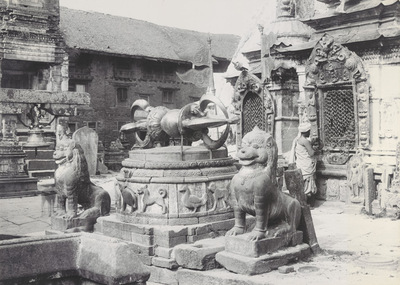Javascript must be enabled to continue!
Judva's Thunderbolt, Shimboonath [Swayambhunath]
View through Europeana Collections
Photograph of the thunderbolt at Swayambhunath in
Nepal. from an album of 30 prints credited to Herzog and Higgins,
taken in ca. 1901 and part of the Curzon Collection. Both Buddhism
and Hinduism have flourished side by side in Nepal for centuries.
Nepalese Buddhism is mostly of the Hinayana and Vajrayana form; the
stupa of Swayambhunath is Nepal's most revered Buddhist temple and
one of the most sacred Buddhist sites in the world. Tradition
believes the stupa to be much older than its 5th century AD
founding. A long stairway leads up to the eastern side of the stupa
and at its head is a huge copper gilt vajra or thunderbolt, placed
on top of a stone mandala (cosmic plan). The vajra was originally
an attribute of Indra, the Hindu god of weather and King of the
Gods. In Vajrayana or Tantric Buddhism, it has assumed a powerful
symbolism, of indestructibility and purity as a diamond and of the
flash of intuition or potent awakening of knowledge. It is a
frequent motif in Nepalese art.
Title: Judva's Thunderbolt, Shimboonath [Swayambhunath]
Description:
Photograph of the thunderbolt at Swayambhunath in
Nepal.
from an album of 30 prints credited to Herzog and Higgins,
taken in ca.
1901 and part of the Curzon Collection.
Both Buddhism
and Hinduism have flourished side by side in Nepal for centuries.
Nepalese Buddhism is mostly of the Hinayana and Vajrayana form; the
stupa of Swayambhunath is Nepal's most revered Buddhist temple and
one of the most sacred Buddhist sites in the world.
Tradition
believes the stupa to be much older than its 5th century AD
founding.
A long stairway leads up to the eastern side of the stupa
and at its head is a huge copper gilt vajra or thunderbolt, placed
on top of a stone mandala (cosmic plan).
The vajra was originally
an attribute of Indra, the Hindu god of weather and King of the
Gods.
In Vajrayana or Tantric Buddhism, it has assumed a powerful
symbolism, of indestructibility and purity as a diamond and of the
flash of intuition or potent awakening of knowledge.
It is a
frequent motif in Nepalese art.
Related Results
A caitya at Svayambhunath
A caitya at Svayambhunath
Watercolour drawing of a shrine at Swayambhunath,
part of the Lawrence collection created by an anonymous artist
working in the Nepalese school, c. 1843-1846. The image is set
with...
The stupa at Svayambhunath
The stupa at Svayambhunath
Pencil, wash and watercolour drawing of the stupa
at Svayambhunath in Nepal, part of the Lawrence collection created
by an anonymous artist, c. 1843-1846. The image, set within a b...
'Thunderbolt'; Leather, blue, English, K Shoes, 1987.
'Thunderbolt'; Leather, blue, English, K Shoes, 1987.
'Thunderbolt'; Leather, blue, English, K Shoes, 1987. ...
Vajrasattva
Vajrasattva
Vajrasattva, ‘the thunderbolt being’, is one of the highestranking Buddhist deities. Here he is seated on a lotus throne, clad in royal attire. In his right hand he generally holds...
Denarius of C. Gargonius, M. Vergilius, and Ogulnius, Rome
Denarius of C. Gargonius, M. Vergilius, and Ogulnius, Rome
Obv.: Head of Apollo to r., wreathed with oak, thunderbolt under neck truncation.
Rev.: Jupiter in quadriga r., holding reins and hurling thunderbolt....
Diobol of Alexandria under Domitian
Diobol of Alexandria under Domitian
Obv.: Laureate bust of Domitian r.
Rev.: Eagle standing on thunderbolt r....
Coin of Alexander the Great, Macedonia mint
Coin of Alexander the Great, Macedonia mint
Obverse: Head of young Heracles r. wearing lion skin.
Reverse: Club l. over quiver and bow l.; above, thunderbolt....
Tetradrachm of Philip II of Macedonia, Amphipolis
Tetradrachm of Philip II of Macedonia, Amphipolis
Obverse: Head of Zeus r., laureate.
Reverse: Young jockey mounted r., carrying palm; below, thunderbolt; in exergue, N [Greek nu]....
Recent Results
Psychoanalysis and Trauma: September 11 Revisited
Psychoanalysis and Trauma: September 11 Revisited
On November 9, 2002, a few hundred people, mostly mental health clinicians, gathered at the New York University Medical Center for two days of discussions on the theme, September 1...
X-radiograph(s) of "St. Paul"
X-radiograph(s) of "St. Paul"
X-Radiograph Description: X-Radiorgaph; Overall
Burroughs Number: 1561
X-Radiograph(s) of:
Artist: Dorsten, Jacob van, Dutch, 1627-1674
Artist: Also att. to Pluym, Karel v...











 Your session has timed out for security reasons.
Your session has timed out for security reasons.